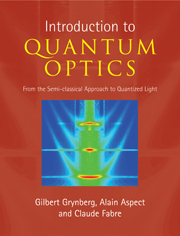47 results
Complement 2A: Classical model of the atom-field interaction: the Lorentz model
-
- Book:
- Introduction to Quantum Optics
- Published online:
- 05 August 2012
- Print publication:
- 02 September 2010, pp 105-119
-
- Chapter
- Export citation

Introduction to Quantum Optics
- From the Semi-classical Approach to Quantized Light
-
- Published online:
- 05 August 2012
- Print publication:
- 02 September 2010
Index
-
- Book:
- Introduction to Quantum Optics
- Published online:
- 05 August 2012
- Print publication:
- 02 September 2010, pp 661-665
-
- Chapter
- Export citation
Complement 3C: Laser light and incoherent light: energy density and number of photons per mode
-
- Book:
- Introduction to Quantum Optics
- Published online:
- 05 August 2012
- Print publication:
- 02 September 2010, pp 247-256
-
- Chapter
- Export citation
7 - Nonlinear optics. From the semi-classical approach to quantum effects
-
- Book:
- Introduction to Quantum Optics
- Published online:
- 05 August 2012
- Print publication:
- 02 September 2010, pp 529-559
-
- Chapter
- Export citation
Complement 5B: One-photon wave packet
-
- Book:
- Introduction to Quantum Optics
- Published online:
- 05 August 2012
- Print publication:
- 02 September 2010, pp 398-412
-
- Chapter
- Export citation
Part I - Semi-classical description of matterlight interaction
-
- Book:
- Introduction to Quantum Optics
- Published online:
- 05 August 2012
- Print publication:
- 02 September 2010, pp 1-2
-
- Chapter
- Export citation
Complement 7B: Nonlinear optics in optical Kerr media
-
- Book:
- Introduction to Quantum Optics
- Published online:
- 05 August 2012
- Print publication:
- 02 September 2010, pp 577-598
-
- Chapter
- Export citation
Complement 3D: The spectral width of a laser: the Schawlow–Townes limit
-
- Book:
- Introduction to Quantum Optics
- Published online:
- 05 August 2012
- Print publication:
- 02 September 2010, pp 257-260
-
- Chapter
- Export citation
3 - Principles of lasers
-
- Book:
- Introduction to Quantum Optics
- Published online:
- 05 August 2012
- Print publication:
- 02 September 2010, pp 191-229
-
- Chapter
- Export citation
Frontmatter
-
- Book:
- Introduction to Quantum Optics
- Published online:
- 05 August 2012
- Print publication:
- 02 September 2010, pp i-vii
-
- Chapter
- Export citation
Complement 3E: The laser as energy source
-
- Book:
- Introduction to Quantum Optics
- Published online:
- 05 August 2012
- Print publication:
- 02 September 2010, pp 261-270
-
- Chapter
- Export citation
4 - Quantization of free radiation
-
- Book:
- Introduction to Quantum Optics
- Published online:
- 05 August 2012
- Print publication:
- 02 September 2010, pp 301-324
-
- Chapter
- Export citation
Complement 5C: Polarization-entangled photons and violation of Bell's inequalities
-
- Book:
- Introduction to Quantum Optics
- Published online:
- 05 August 2012
- Print publication:
- 02 September 2010, pp 413-433
-
- Chapter
- Export citation
Complement 6C: Polarization-entangled photon pairs emitted in an atomic radiative cascade
-
- Book:
- Introduction to Quantum Optics
- Published online:
- 05 August 2012
- Print publication:
- 02 September 2010, pp 518-526
-
- Chapter
- Export citation
Complement 1B: Transition induced by a random broadband perturbation
-
- Book:
- Introduction to Quantum Optics
- Published online:
- 05 August 2012
- Print publication:
- 02 September 2010, pp 38-44
-
- Chapter
- Export citation
8 - Laser manipulation of atoms. From incoherent atom optics to atom lasers
-
- Book:
- Introduction to Quantum Optics
- Published online:
- 05 August 2012
- Print publication:
- 02 September 2010, pp 599-650
-
- Chapter
- Export citation
6 - Interaction of an atom with the quantized electromagnetic field
-
- Book:
- Introduction to Quantum Optics
- Published online:
- 05 August 2012
- Print publication:
- 02 September 2010, pp 457-497
-
- Chapter
- Export citation
Foreword
-
- Book:
- Introduction to Quantum Optics
- Published online:
- 05 August 2012
- Print publication:
- 02 September 2010, pp xxiii-xxiv
-
- Chapter
- Export citation
Complement 6B: Cavity quantum electrodynamics
-
- Book:
- Introduction to Quantum Optics
- Published online:
- 05 August 2012
- Print publication:
- 02 September 2010, pp 502-517
-
- Chapter
- Export citation

